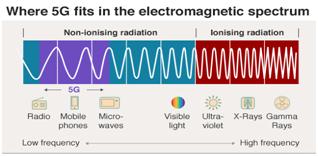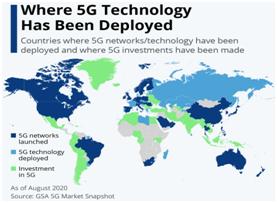

Mukesh Ambani led Reliance Jio has declared that they will launch 5G in the 2nd half of 2021.
Context
Mukesh Ambani led Reliance Jio has declared that they will launch 5G in the 2nd half of 2021.
Background
- Previously, Jio had revealed it had set up core architecture and was ready to switch to 5G as soon as the spectrum auction came around.
- Mukesh Ambani had announced in July that Jio would start testing its homegrown 5G solution as soon as the spectrum was available. The announcement was made during RIL’s 43rd Annual General Meeting.
- At the Qualcomm 5G Summit in October, Jio had announced the development of its 5G Radio Access Network (RAN) designed to test 5G network at scale.
- Jio has been working with companies like Samsung and Qualcomm to bring 5G to India.
Analysis
What is 5G?
- 5G is the 5th generation of mobile networks, a significant evolution of today’s 4G LTE networks.
- It is the next-generation cellular technology that will provide faster and more reliable communication with ultra-low latency.
- Even after the entry of 5G into the Indian networks, the earlier generation mobile technologies (2G, 3G and 4G) will continue to remain in use and that it may take 10 or more years to phase them out.
- 5G uses radio waves or radio frequency (RF) energy to transmit and receive voice and data connecting our communities
What are the potential applications of 5G?
Sustainable pricing of spectrum, stable policy and regulatory landscape, and innovative use cases are estimated to be key enablers accelerating the growth of the 5G market in India. Agriculture, automotive, manufacturing, healthcare, energy & utilities, and media & entertainment are likely to be the potential end-user industries of 5G.
- Telecom sector: 5G will positively impact India's telecom market, the second largest in the world and "still growing", as increased data consumption and heightened adoption of technology due to the pandemic has prepared the market for the advent of next-generation technology.
- Agriculture: It is expected to revolutionize the agriculture industry through high-speed data transfer in agricultural drone, smart irrigation, precision farming, and monitoring of soil, crop and livestock.
- Automotive industry: In the automotive industry, 5G is expected to fast track the implementation of connected cars, V2X (vehicle to everything), autonomous driving, and smart transportation system.
- Manufacturing industry: The manufacturing industry is predicted to leverage 5G in connected and smart factories, synchronized planning, smart supply-chain network, and smart logistic operations.
- Healthcare industry: Furthermore, 5G is likely to digitally transform the healthcare industry through the application of internet of medical things (IoMT), connected healthcare, patient data management and online consultation.
- Application in smart cities: 5G is expected to find extensive use in smart cities. The major smart city applications of 5G are anticipated to be smart utility management systems, smart grids and metering systems, smart traffic management systems, smart traffic lights, video surveillance and analytics, and waste management.
- Supporting applications and services: It is expected to form the backbone of emerging technologies such as the Internet of Things (IoT) and machine to machine communications, thereby supporting a much larger range of applications and services, including driverless vehicles, telesurgery and real-time data analytics.
- Government: This revolution will also provide an opportunity for the government to improve it’s connected with the citizens. Digitalisation could help improve the delivery of government services to citizens and also lower transaction costs for citizens.
Why does India need 5G?
- Internet speed: The quick adoption of 5G technology, which has been in the works for some time now, can facilitate a quick ramp-up in internet speeds in this country. 5G has a high data speed, which improves mobility and user experience.
- Creating adequate infrastructure: India has been the largest consumer of data in the world. The country accounted for the consumption of 11 GB data per month per user, on an average. The existing broadband technology falls short to meet the soaring demand owing to lack of adequate infrastructure.
- Filling required gaps: 5G has enormous potential to accomplish the various gaps of the existing 4G LTE technology like low mobility speed, high latency and capital intensive deployment.
- Smarter, faster and efficient infrastructure: This new technology backbone is smarter, more efficient and up to 100 times faster than the 2G, 3G and 4G networks currently in use in India and can open up the economic potential of an unimaginable magnitude.
- Transformation of vital sectors: It can exponentially transform sectors such as communications, data management, analytics, fintech, healthcare, autonomous vehicles and entertainment facilitate smart cities, smart homes, and the IoT.
What are the fundamental issues in rolling out 5G networks?
- Spectrum: In India, 5G spectrum is yet to be allocated. This means full-fledged trials are still pending which is needed for telecom operators to test their technology.
- Too expensive affair: The 5G spectrum auction has been delayed in India is because it is too expensive for telecom companies.
- Findings space: One other challenge when deploying 5G is the acquisition of sites.
- Fiberization: Another major challenge that has to be tackled is the paucity of fibre optic links. In India, only about 25-30 percent of telecom towers are connected by fibre links; the rest are connected by radio waves.
- Universal adoption of 5G will require at least 50-60 percent of towers to be connected by fibre – ideally, before the launch of the new technology. In the US and China, about 80 percent of all telecom towers have fibre links.
- Other challenges are:
- Right of Way(RoW) and lack of uniform policy framework
- Limited giga-backhauling to meet future requirements
- Industry crippling under margin pressure
- Network modernisation and densification will be complex
- Strengthening the security apparatus with evolving technologies
Which countries have already launched 5G services?
Globally, 5G network deployment is rapidly moving from trials to early commercialisation.
- In April 2019, South Korea and the U.S. became the first countries to commercially launch 5G services.
- China too has handed out commercial 5G licences to its major carriers earlier than expected.
- Other countries include Japan, Australia, United Kingdom, Qatar, Kuwait, the United Arab Emirates and others.
Conclusion
With a confluence of technologies (IoT, big data, edge computing, AI, etc.) maturing together, 5G is set to be a game-changer for the telecom industry and is expected to yield enormous economic opportunities. The augmentation of enterprise 5G will impact almost all major sectors, with the potential to unlock USD4.8 trillion globally. To make 5G a reality in India, government and industry collaboration with 5G network providers is needed to achieve long-term objectives.




